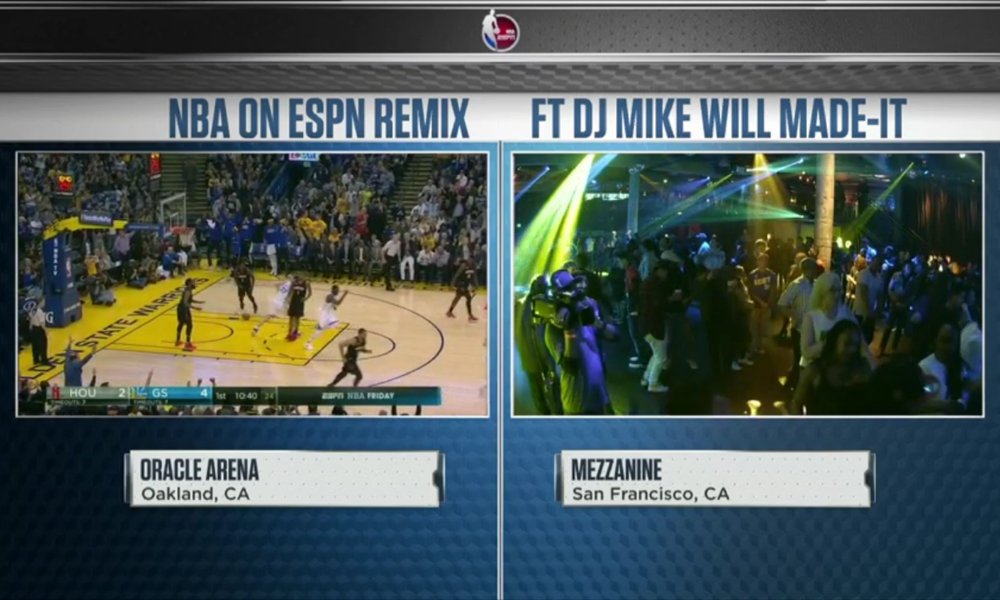ESPN Throws a Party, Mixing Basketball and Tunes
Inside the successful experiment uniting digital media, game viewing, and live entertainment
Story Highlights
Last month, ESPN treated several hundred basketball-loving San Franciscans to a unique viewing experience called “NBA on ESPN Remix.” In an experiment designed to engage its younger fans, the network turned the city’s Mezzanine bar into a music-filled viewing party for a game between the Golden State Warriors and the Houston Rockets.

ESPN3 allowed viewers outside the Bay Area to watch a split-screen view of the game on one side and the party on the other.
The game was projected on two giant screens, and DJ Mike WiLL Made-It called it with improvised rhymes and songs mixed to match the action. Although attendance was limited to people in the Bay Area, anyone with ESPN3 could watch the party on a split-screen view, with the game on one side and the party on the other.
“With the NBA, there’s always this natural intersection of sports and music,” says Sean Hanrahan, SVP, brand and marketing solutions, ESPN. “The idea to create a music-filled party grew out of a brainstorming session looking for ways to complement a regular broadcast and reach out to millennial viewers. ESPN thought a viewing party with a DJ creating a fresh soundtrack to a game sounded like something they wanted to try.”
ESPN chose the DJ on a recommendation from its internal music group and decided that the party would have the best chance of success if held in the Warriors’ backyard. Finding a venue with large projection screens built-in meant setup was minimal.
Promotion for the event started a week ahead of time, with the venue putting a notice on its website and Facebook page and ESPN amplifying that through its social channels. Guests were asked to RSVP, but the event didn’t reach capacity so unregistered guests were allowed in.
The network went all-out creating the broadcast experience with a six-camera setup: three fixed cameras — one showing the DJ’s point of view, two with different angles — and three others roaming the floor. The regular ESPN broadcast mentioned the party a few times during the game, telling viewers they could switch to ESPN3 if they wanted to see more. The party started at 7:30 p.m. local time and attracted around 1,000 people over the evening, with peak attendance around 9 p.m. The ESPN3 broadcast attracted about 5,000 viewers.

Sean Hanrahan, SVP, brand and marketing solutions, ESPN
In the end, the home team won, and the crowd was happy.
Now that ESPN has conducted a successful experiment, it’s time for a post-mortem to decide what could be improved next time around. There might be a next time — that’s still undecided — but it wouldn’t be until next season.
The first thing Hanrahan would do differently is choose a game with a later start time. Getting young people in a club at 7:30 is too much of a challenge. That’s just too early for a dance club, he says. “We probably would’ve had a bigger crowd if we were able to start it later. But, as the evening went on, the crowd came.”
Promotion is crucial for an unusual event like this, and Hanrahan would like to give any future parties more visibility. Although the regular ESPN commentators mentioned the ESPN3 view a few times during the game, he thinks mentions in the days leading up to it would have helped as well.
Since this was a first-of-its-kind event, there was no sponsor, but that would certainly change in the future.
“I believe it’s highly sponsorable,” Hanrahan says. “If we were committed to doing this going forward, we would obviously take it out well in advance through our sales force and expose it to the marketplace, and I bet you we’d get a lot of interest. I think advertisers would see it as the same opportunity to test something, because there’s a lot of folks that like to be in this space. So, yeah, I think it’d be a great opportunity for a sponsor.”
In examining the event to decide whether it should be repeated, ESPN will look at metrics like the average-minute audience to learn what kind of fans were attracted and will study attendance at the club itself. Next time, ESPN will also get direct feedback from the fans, which was not done during this first experiment. Although Hanrahan wasn’t at Mezzanine, he heard good reports from team members who were.
“Everybody thought it was really cool. Everybody liked being there and thought it was great that ESPN was doing this,” Hanrahan says. “So I think there’s a little brand halo effect, too, that ESPN was bringing this to the fans. That’s always a good thing.”
